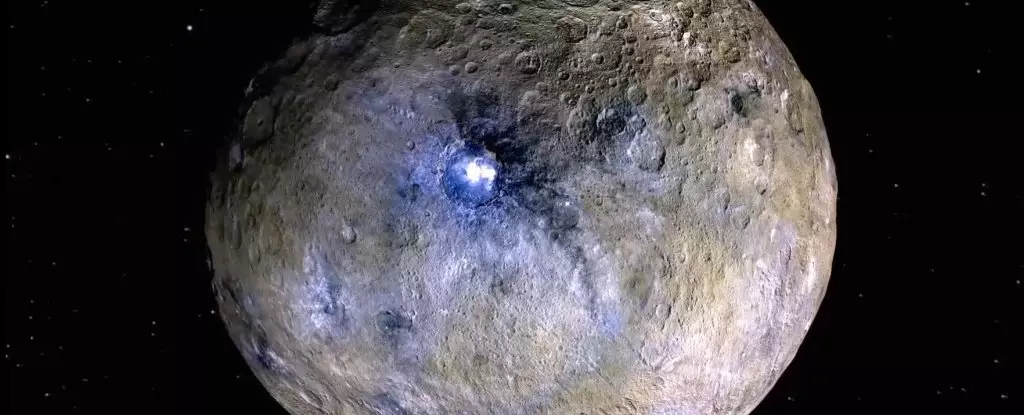Ceres, the largest object residing in the asteroid belt between Mars and Jupiter, has piqued the interest of scientists for over two centuries. Initially classified as an asteroid upon its discovery in 1801, Ceres has earned a distinctive status as a dwarf planet, offering an abundance of intriguing characteristics that distinguish it from its celestial neighbors. Recent revelations suggest that beneath its rugged exterior lies a significant amount of water ice, potentially reshaping our understanding of icy bodies in the cosmos and spurring new inquiries into the nature of planetary formation and evolution.
Recent investigations reveal that Ceres may be composed of over 90 percent water ice in its crust. This discovery marks a substantial increase in estimates from previous studies, which posited that the ice content might not exceed 30 percent based on the degree of cratering observed on the surface. The prevailing belief held that a predominantly icy surface would undergo significant deformation over time, causing craters to lose their well-defined shapes—a theory that has now been challenged. Purdue University planetary geophysicist Mike Sori sheds light on this, suggesting that even a small mixture of rocky material can enhance the strength of ice, permitting it to maintain its structural integrity over vast geological timescales.
The turning point in our understanding of Ceres arrived with NASA’s Dawn spacecraft, which orbited the dwarf planet from 2015 to 2018. The findings from Dawn indicated well-preserved craters on Ceres’s surface, contradicting earlier assumptions about icy bodies. Ian Pamerleau, a planetary scientist at Purdue, alongside his team, used data collected from Dawn and advanced computer simulations to challenge the notion of rapid surface deformation. Their research suggests that the incorporation of even minor amounts of solid rock into an icy crust could allow Ceres to retain its prominent craters through solid-state flow processes.
While ice typically flows like a viscous fluid, the unique conditions on Ceres alter this behavior. The simulations explore how a layered crust—featuring a high ice concentration near the surface and transitioning to lower amounts of ice with depth—could lead to a preserved surface morphology. This finding not only provides a new perspective on Ceres but also expands our understanding of similar bodies throughout the Solar System.
Ceres’s potential icy crust might share characteristics with other ocean worlds known to inhabit the Solar System. Comparisons can be drawn with celestial bodies like Jupiter’s moon Europa and Saturn’s Enceladus, both believed to contain subsurface oceans beneath thick ice shells. Notably, these moons experience tidal heating due to their interaction with their respective planets, which helps to keep their interiors warm.
In contrast, Ceres does not orbit a planet, eliminating the possibility of tidal heating. This absence brings forth an intriguing hypothesis: if Ceres once hosted a liquid ocean, it has since frozen over, creating a static surface. Sori suggests that Ceres may reflect the past conditions of these ocean worlds, providing a unique and accessible opportunity to study icy environments.
The understanding of Ceres as a frozen ocean world introduces perspectives on how different icy bodies can be. Its proximity to Earth enhances its potential significance as a research target for future missions. The notion that Ceres serves as a “frozen ocean world” allows scientists to reconsider definitions of habitability and the underlying mechanisms that foster the emergence of life across diverse environments.
The tantalizing possibility that Ceres could provide essential insights into the icy moons of our Solar System opens new avenues for exploration. As researchers continue to analyze the data obtained from the Dawn mission and conduct simulations, they aim to unravel more secrets embedded within Ceres’s frozen crust. The dwarf planet, previously overlooked amidst the grandeur of its planetary counterparts, deserves its place as a focal point of interplanetary research and the quest for understanding our cosmic neighborhood.
The latest research on Ceres shifts our understanding of what lies beneath this enigmatic dwarf planet. By refining our models and exploring the implications of an icy-rich crust, scientists are beginning to appreciate that not all ocean worlds share the same characteristics or conditions. As one of the most accessible icy bodies in the universe, Ceres holds boundless potential for future studies, inviting humanity to expand its horizons and deepen its understanding of life’s possibilities beyond Earth. As exploration continues, we find ourselves on the brink of uncovering exciting revelations that could transform our perspective on planetary science and the essence of icy worlds in our Solar System.

